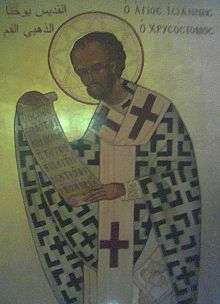Synod of the Oak

The Synod of the Oak was a provincial synod, held in Constantinople in July of 403, which condemned and deposed John Chrysostom as Patriarch of Constantinople.
The synod is widely seen as politically motivated, being the result of a conspiracy by a number of Chrysostom's opponents, including the Empress Eudoxia and Pope Theophilus of Alexandria.
Preamble
In the year 402, Theophilus had been summoned by the emperor to Constantinople to apologize before a synod, over which Chrysostom would preside, on account of several charges which were brought against him by certain Egyptian monks, especially by the so-called four "Tall Brothers". Theophilus, their former friend, had suddenly turned against them, and had them persecuted as Origenists.[1] Placing himself at the head of soldiers and armed servants Theophilus marched against the monks, burned their dwellings, and ill-treated those whom he captured.[2][3]
When these monks fled to Constantinople to appeal to Patriarch John, Theophilus wrote to St. Epiphanius of Cyprus, requesting him to go to and prevail upon Chrysostom to condemn the Origenists. Epiphanius went, but when he realized that Theophilus was merely using him for his own purposes, he left the capital, dying on his return in 403. At this time Chrysostom delivered a sermon against the vain luxury of women. It was reported to the empress as though Chrysostom had been referring to her personally, which only embittered her more against the Patriarch.
The synod
Theophilus at last appeared at Constantinople in June, 403, not alone, as he had been commanded, but with twenty-nine of his suffragan bishops, and, as Palladius tells us, with a good deal of money and all sorts of gifts.[4] His nephew and successor Cyril also accompanied him to the synod. Theophilus took his lodgings in one of the imperial palaces, and held conferences with all the adversaries of Chrysostom. Then he retired with his suffragans and seven other bishops to a villa near Constantinople, called Epi Dryn.[5] A long list of unfounded accusations was drawn up against Chrysostom.[6]
The synod now consisted of forty-two archbishops and bishops, many of whom were Syrian and Egyptian bishops inimical to him brought by Theophilus. So now the synod, assembled to judge Theophilus in accordance with the orders of the emperor, now summoned Chrysostom to present himself and apologize. Severian, Bishop of Gabala in Syria, whom Chrysostom had previously ordered to leave Constantinople because of his involvement in a plot against the patriarch, served as prosecutor.[7] Chrysostom naturally refused to recognize the legality of a synod in which his open enemies were judges. After the third summons Chrysostom, with the consent of the emperor, was declared to be deposed. In order to avoid useless bloodshed, he surrendered himself on the third day to the soldiers who awaited him. But the threats of the excited people, and a sudden accident in the imperial palace, frightened the empress.[8] She feared some punishment from heaven for Chrysostom's exile, and immediately ordered his recall. After some hesitation, Chrysostom re-entered the capital amid the great rejoicing of the people. Theophilus and his party saved themselves by fleeing from Constantinople.[9]
Aftermath
Chrysostom's enemies, though, did not rest, and soon succeeded in having him deposed and exiled a second time, on 24 June 404. Saint John Chrysostom's last words, delivered as he lay dying on the road to exile, were "Glory be to God for all things!"
References
- ↑ Palladius, Dialogus, xvi; Socrates Scholasticus, Ecclesiastical History, VI, 7; Sozomen, Ecclesiastical History, VIII, 12.
- ↑ Palladius, vii; Socrates, op. cit. For Jerome's congratulations to Theophilus see Jerome, Epistle lxxxvi.
- ↑ Chrysostom Baur (1912), "Theophilus, The Catholic Encyclopedia, Vol. XIV (New York: Robert Appleton Company)
- ↑ Palladius, op. cit., ch. viii
- ↑ Ubaldi, La Synodo ad Quercum, Turin, 1902
- ↑ Photius, Bibliotheca, 59, in Migne, Patrologia Graecae, CIII, 105-113
- ↑ http://www.newadvent.org/cathen/13742b.htm
- ↑ Palladius, Dialogus, ix
- ↑ Chrysostom Baur (1910), "St. John Chrysostom", The Catholic Encyclopedia, Vol. VIII (New York: Robert Appleton Company)
External links
- Episcopal Conspirators chapter from Gathering Clouds: A Tale of the Days of St. Chrysostom by Frederic William Farrar
